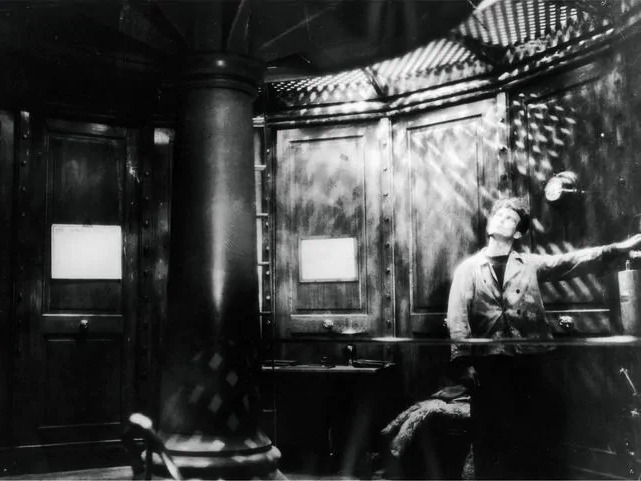GARDIENS DE PHARE
(The Lighthouse Keepers)
Jean Grémillon (FR 1929)
A father and son bid farewell, one to his wife, the other to his fiancée, and set off in a boat for a thirty-day duty as lighthouse keepers. Yvon shows his father the bite inflicted by a dog during a stroll with his fiancée; in the meantime, rabies has been diagnosed in their village. Unaware of the danger, the two men take turns watching the lighthouse, which must be lit every night. Père Bréhan imagines the party planned for the wedding, but soon the feverish Yvon feels increasingly ill. His father cannot seek help because a storm has blown up and the sea is raging. Yvon becomes more and more aggressive, preventing his father from relighting the lighthouse, while a ship in distress sounds its siren. While the women on shore learn about the rabies epidemic and realize what is happening, Bréhan fights with Yvon and pushes him into the void. Overwhelmed with grief, he lights the beam again.
Autier and Cloquemin’s melodrama was a huge popular success – theatrically (its run at the Grand Guignol lasted several months), in print (the book went through eight editions between 1905 and 1928), and in cinemas. The first film version was made in Turkey in 1923 by Muhsin Ertugrul with the title Kiz Kulesinde bir facia (The Tragedy at Kizkulesi).
Born in 1901 in Bayeux, Normandy, in modest circumstances, Jean Grémillon had two mentors: the director Charles Dullin, a founder (with Louis Jouvet, Gaston Baty, and Georges Pitoëff) of the Cartel des Quatre (Group of Four) in 1927, and the producer of Maldone (1928), in which he played the title role; and Jacques Feyder, one of the most brilliant filmmakers of his generation, who created the cinema cutting continuity of the play Gardiens de phare. This prestigious dual ancestry should account for an understanding of the young director’s artistic creed. The original music for Gardiens de phare, which remains lost, was composed by Grémillon himself; he had been trained at the Schola Cantorum in Paris, where he studied with Vincent d’Indy.
The main character is played by Geymond Vital (1897-1987), a member of Charles Dullin’s troupe at the Théâtre de l’Atelier and a regular actor there since 1922. Vital already had five film credits, including (all in 1928) René Clair’s Un Chapeau de paille d’Italie, Grémillon’s Maldone (in which he plays Maldone’s brother), and Georges Lacombe’s La Zone (produced, like Maldone, by Charles Dullin).
The film is original in various ways: it has a documentary quality, recording life and work in the lighthouse, and the women who harvest seaweed on shore; it conveys the extraordinary architectural luminosity inside the lighthouse and the views of the swollen sea around it. It also has an audacious narrative, intertwining scenes in the present (intercutting land and lighthouse), the past (the betrothed couple walking on the beach), the anticipated future (the marriage), and the nightmares of the rabies-stricken son.
The editing also plays on the opposition of plastic forms: the entirely motion-filled element of the sea, open, evanescent and boundless, versus views of the lighthouse, stable, grounded, and with a crisp outline. Cameraman Georges Périnal’s shots of the sea most often involve foaming waves shattering in disordered violence, whereas the light of the lighthouse seen from within is, on the contrary, a complex but perfectly geometrical luminous architecture: the low-angle shots of the enormous lamp turning on itself frame reflections cut into infinite segments by the metal awnings, and convey an effect of cyclopean power. In this epic combat between the lighthouse and the sea, men are victims rather than referees; it is as if the father had to sacrifice his son in order to calm the anger of the elements (one thinks of Agamemnon sacrificing Iphigenia so that the Greek fleet could attack Troy). Likewise, the hostility of nature is evoked by rabies, which seizes the dog and condemns the young man to a ghastly death. The conflict between mankind and nature also extends to the separation between the men and their women on shore, divided between fear and hope; they are united solely through memory, dream, or fantasy. Grémillon’s cosmic staging transforms melodrama into tragedy.
Shooting began in August 1928 but the production was interrupted, with many exteriors already completed, by a serious car accident after which Gilbert Dalleu (who was playing Bréhan, the father) had to have his right arm amputated. Paul Fromet was cast in the role in 1929 and all the scenes were started anew. Dalleu died as a result of his injuries in 1931.
The original film was long considered “lost at sea”, to use Jean Grémillon’s picturesque expression; it was only in 1954 that a copy was found in Denmark. Grémillon had planned to write a new musical score himself, but died in 1959 before he could achieve his goal.
Geneviève Sellier
The print shown here comes from the collection of Komiya Tomijiro, now preserved at the National Film Archive of Japan (formerly known as the National Film Center). The copy derives from a beautiful first-generation positive struck for distribution in English-speaking countries, whose subtle grading enhances Jean Jouannetaud’s and Georges Périnal’s pictorial tour de force. [Ed.]


regia/dir, mont/ed: Jean Grémillon.
scen: Jacques Feyder, dalla pièce di/based on the play by Paul Autier, Paul Cloquemin (08.03.1905, Théâtre du Grand Guignol, Paris).
photog: Jean Jouannetaud (1928), Georges Périnal (1929).
scg/des: André Barsacq.
asst: Jean Mamy, André Barsacq.
cast: Geymond Vital (Yvon Bréhan), Paul Fromet (suo padre/Yvon’s father), Génica Athanasiou (Marie), Gabrielle Fontan (sua madre/Marie’s mother).
prod: Société des Films du Grand Guignol.
dist: Films Armor.
riprese/filmed: (1) 08-09.1928 (Studios Billancourt), (2) 04-05.1929 (Studios Gaumont-Buttes Chaumont); locs: Bretagne (Saint-Guénolé; Île-de-Bréhat; Perros-Guirec; Triagoz [faro/lighthouse]; Port-Blanc).
première: 25.09.1929 (Ciné-Max Linder, Paris).
uscita/rel: 4-17.10.1929 (Ciné-Max Linder, Paris); première (sd. vers.): 28.05.1930 (Artistic Cinéma, Paris).
copia/copy: 35mm, 1693 m. (orig. 2400 m.), 82′ (18 fps), imbibito/tinted; did./titles: FRA, ENG.
fonte/source: National Film Archive of Japan, Tokyo (Komiya Collection).




